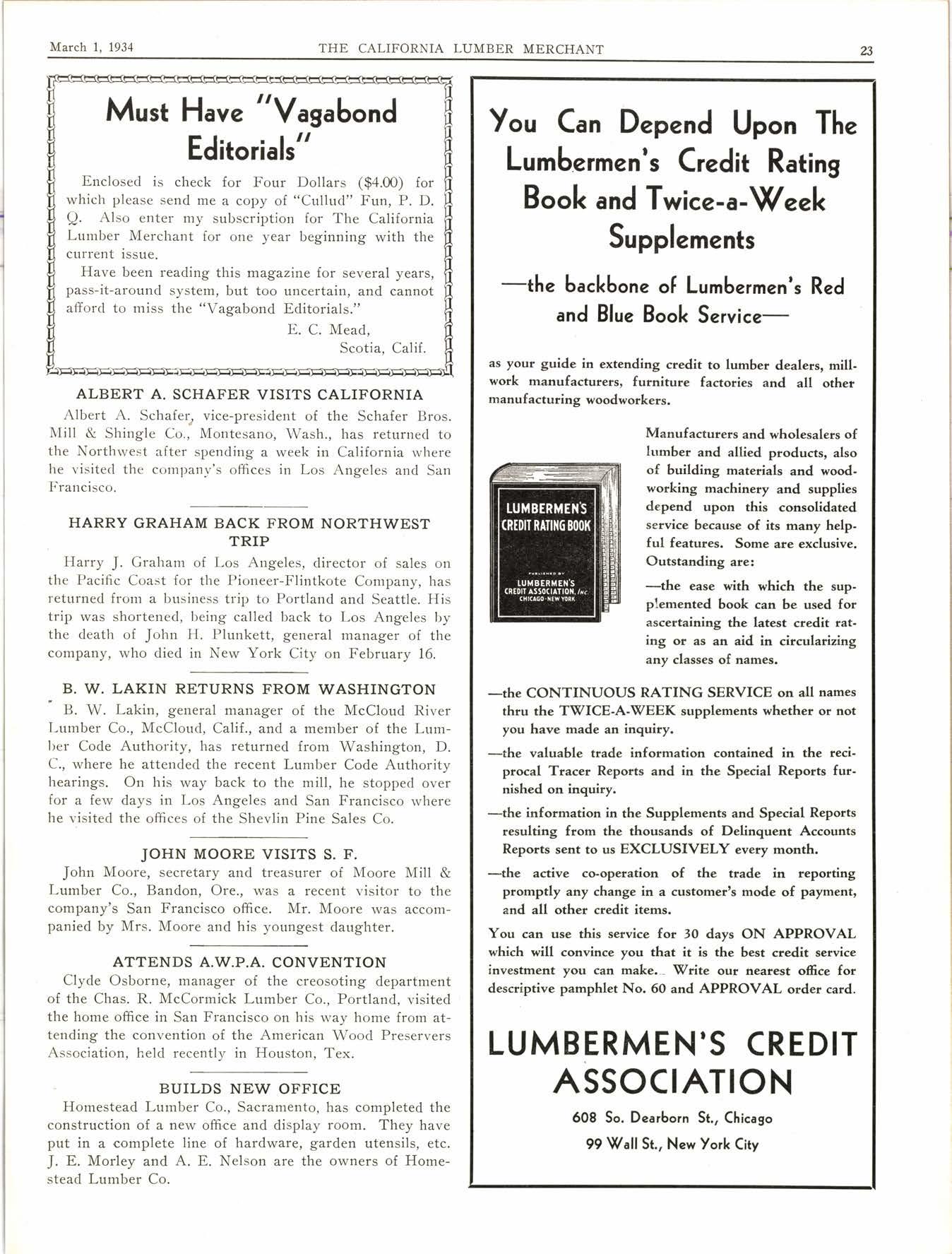
3 minute read
Reforestation Goes Into Effect )une 1
Washington, February 9.-The Lumber Code Authority, in session here, today adopted what is virtually the primary reforestation law for all commer,cial timber lands subject to the ,code governing the lumber and timber products industries. Broad basic rules governing forest operations, looking to the maintenance of forests through sustained yield practice, were written into a forestry code and added to the Lumber Code as Supplement C. This forestry code is as binding on the forest industries in respect of rnaintaining their forests in a reproductive condition as the provisions relating to allocation of produ,ction, cost protection, minimum wages and maximum hours, or anything else in the code, are in their respective fields.
When the supplement is approved by President Roosevelt it becomes in eflect the federal law of the forests.
Foresters and lumbermen alike pointed out today that, as with so many other projects under President Roosevelt, what has been for. generations a subject of harmless conversation or academic dissertation has become a reality enforcible by the authority of the Government of the United States.
Ofti.cers of the Lumber Code Authority calculate that the new law of the forest will apply at once to about 250 million acres of land owned by industrial and timber holding companies. The low will also apply, it is believed, to that portion of the 125 million acres of farm timberlands which are commercially utilized. The total forest area of the United States is put at something over 500 million acres, but about 180 million acres are in national and state forests or some other form of public domain. As most of the publicly owned forests are already under forestry administration, it may be roughly generalized-according to lumber,code officers-that the United States n,ow becomes one of those ,countries whose forests are entirely under conservative utilization.
Foresters say that much more needs to be done in order fully to realize the ideal of sustained yield set by the Lumber Code, but they are delighted with such widespread positive progress toward reforestation and look for further refinements of forestry practice as the forest industries become accustomed to lumbering and logging under the nerv regulations. The basic rules for the country as a whole are as follows:
1. Protection of standing timber and young trees from fire and other destructive forces.
2. Prevention of damage to young trees during logging operations.
3. Provision for replanting the cleared land after logging, if sufficient advan,ce growth .is not already present.
4. To leave, where feasible, some portion of the merchantable timber as a basis for growth and the next timber crop.
5. Partial cutting or selective logging shall be the general standard of forest practice.
A premium for the practice of sustained yield lumbering under these rules is awarded in the form of a 10 per cent increase in quotas of production.
The general rules are to be adapted to the requirements of terrain and climate in each regional division or subdivision under the code. These adaptations must be filed with the Code Authorify by April 1Sth and practice of them will be obligatory upon all persons sdbject to the Code, not later than June 1, 1934.
Code Authority Conlerence
Washington, Feb. 15.-One year and one day after his inauguration, President Roosevelt will address what probably will be the greatest gathering of leaders of industry and trade in the country's history-the conference of Code Authorities and trade association committees scheduled to be held in Washington March 5 to March 8.
Invitations to participate in the conference to determine practical measures to meet problems which have arisen in actual code operation, have been forwarded by National Recovery Administrator ,Hugh S. Johnson to nearly 7000 members of the Authorities created under approved Codes and also to the trade association code committees representing those industries whose proposed Codes, having been considered in public hearings, are now awaiting formal approval.
A total of. 278 Codes covering approximately 9O per cent of all industry and trade have been approved to date and another 353, most of them for relatively small industries, on which public hearings have been held, are in course of preparation for final approval.
In his call for the conference, the opening sessions of which are to be held in Constitution Hall, General Johnson outlined the major purposes to include "the consideration in public sessions of the possibilities of increasing employment; protections against destructive competiton and against excessive prices and monopolistic tendencies; the elimination of inequalities and inconsistencies in codes; the position of small enterprises; and the vast problem of code administration and the organization of industry for selfgovernment."
In his invitations to the conference, General Johnson not only requested the submission before February 20 of "such questions, or suggestions, which, in your judgment, may improve the policy or procedure of the National Recovery Administration" but he also urged participants to come prepared to discuss details of the effect of the codes on their particular industries.
Following the opening session on March 5 to be addressed by the President and General Johnson, the general conference will be divided into several public group meetings to be followed by group conferences of Code Authorities and Code Committees with the Administration and a final general conference of selected delegates of each Code Authority and Committee with the Administrator.








